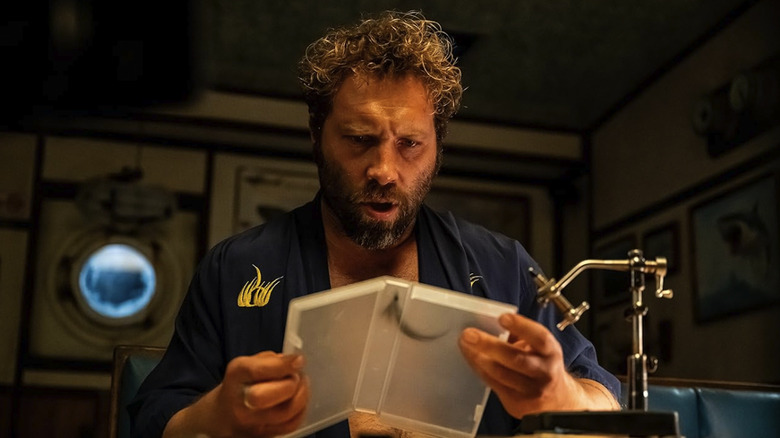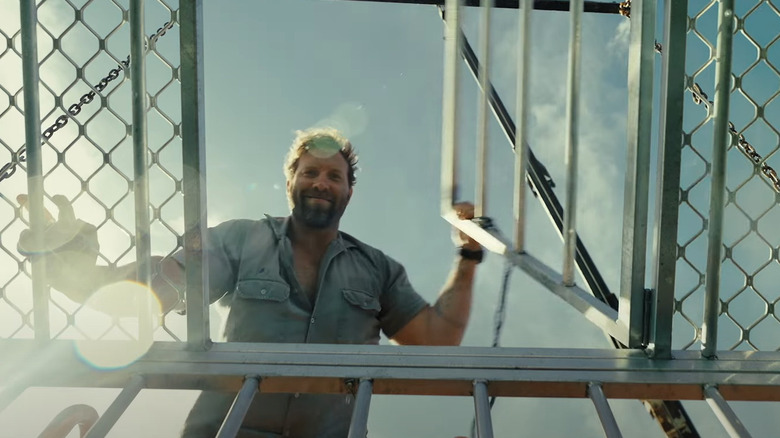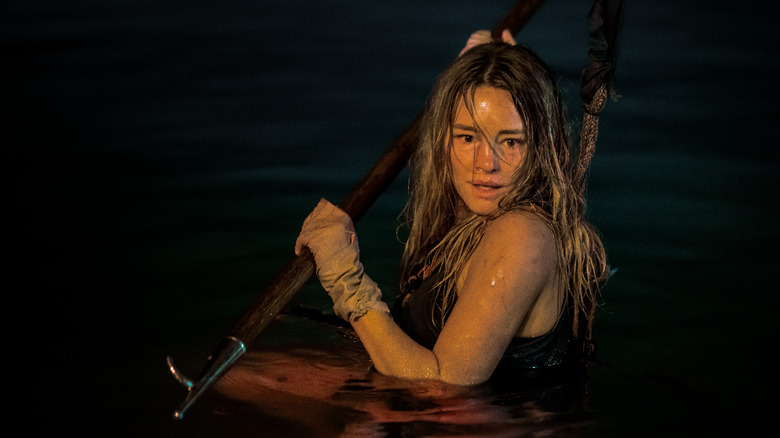Dangerous Animals Offers A Nasty, Brutal Twist On A Steven Spielberg Classic
50 years ago, the general public's view of the ocean — in particular, the presence of sharks within it — changed forever with the release of Steven Spielberg's "Jaws." While shark attack movies had been made for decades prior to Spielberg's adaptation of Peter Benchley's novel, these films tended to fall into the "exotic adventure" category, i.e. films about characters or real-life figures who traveled to far-away lands and encountered dangerous wildlife there. "Jaws" brought the killer shark essentially right to people's doorsteps (something "Saturday Night Live" made reference to in a literal way), conveying that the threat the animals posed wasn't relegated to distant shores. Whether or not this creative decision was irresponsible when it comes to informing the public about actual shark behavior is beside the point; "Jaws" never purported to be a fact-based documentary, but simply a horror/adventure yarn, and it's a ripping great one at that.
Still, given the still-thriving subgenre of the shark attack movie that "Jaws" made continually popular, perhaps the film owes a debt to the poor shark — or at least, perhaps another film could try and redress the balance between an animal that's simply following its nature and the much more insidious (and intentionally murderous) beast known as Man. Although there are numerous stories comparing humans to animals with the intention of stating that the real monsters are human beings, a movie which does this explicitly within the shark attack subgenre is this summer's "Dangerous Animals." Sean Byrne's movie, written by Nick Lepard, is a gripping, tense, and disturbing take on the serial killer film, one which hits all the expected beats in a satisfying if clichéd fashion. What makes "Dangerous Animals" unique is how it subverts the tropes of the shark attack film, and especially how it references those tropes as established by "Jaws," turning the movie into a dark mirror of the Spielberg classic.
Jai Courtney's Tucker is Quint gone bad
Throughout the tradition of Man vs. Nature parables, there's usually a character archetype of the Great Hunter, a figure who supposedly has a great deal of experience with and authority over the animal kingdom. Quite often, this figure becomes a victim of their own hubris, becoming the prey when they have lived so long thinking they're the predator. (Think of actor Bob Peck's take on Robert Muldoon in Spielberg's "Jurassic Park," for instance.) Sometimes this hubris occurs through simple arrogance, but other times it's due to the character being obsessed with their quarry, a trope popularized by Captain Ahab in Herman Melville's "Moby Dick." In "Jaws," the character of Quint (played by Robert Shaw) is an Ahab type, seeing as how he considers himself the world's foremost expert on shark hunting and soon becomes obsessed with capturing the giant shark terrorizing Amity Island when it begins to elude his efforts. It turns out that Quint's obsession with the shark goes back to his experience surviving the sinking of the USS Indianapolis during World War II, in which he and other sailors were forced to contend with shark-infested waters upon escaping their boat.
In "Dangerous Animals," Tucker (played by Jai Courtney) has a similar backstory to Quint's, in that he famously survived a brutal shark attack when he ran away as a boy. Like Quint, he's still got the scars to prove it, and happily shows them off to tourists who book his boat to go shark sightseeing off the coast of Australia. However, where Quint's Indianapolis experience instills in him a lifelong grudge with the shark, Tucker begins to align himself with the shark instead, considering them both to be loners, survivors, and — most disturbingly — natural predators, which is part of what allows Tucker to help justify his secret life as a serial killer. Even though Tucker generally adheres to the Great Hunter archetype, it's a dark reflection of the trope, making him identify not as the animals' superior, but as their equal.
Dangerous Animals has empathy for sharks while still using them as threats
The other part of Tucker's internal justification for his killings is that, in his mind, he's not actually killing anyone. His modus operandi is to hook his victims up to a crane and dip them into the ocean after chumming the waters, making certain that a hungry shark will come along and have his victim for dinner. It's this aspect of "Dangerous Animals" which lends its serial killer story some intriguing color and its shark attack heritage a nasty, brutal twist. While many of Tucker's habits can be seen in many a serial killer movie — the man kidnaps his victims, drugs them, holds them in a locked compartment in his boat, and keeps a memento of their deaths to enjoy and relive later — his method of murder is comparable to far fewer ancestors. The closest relative to Tucker would be Stuntman Mike (Kurt Russell) from Quentin Tarantino's "Death Proof," which contains a whole "Psycho"-esque scene of an authority figure explaining how Mike's car is his preferred weapon. Thus, sharks are Tucker's version of a knife, chainsaw, or more traditional implement of murder.
As rare as this plot element is in the serial killer movie, it's even more rare in the shark attack movie. While there have certainly been killer shark films which pay lip service to the reality that sharks are not insidious, pre-meditated murderers, most killer shark movies depict the animals as cold and ruthless beasts who are nearly unsurvivable. This depiction can be traced back to "Jaws," which turned the great white shark into a nearly-supernatural creature, for reasons both intentional (to pump up the horror and suspense) and necessary (to get around the production's mechanical shark not working). "Dangerous Animals" seeks to take the onus off the killer shark, using their dangerous but not malicious nature as a comparison point to Tucker's fully cognizant evil. The film's riff on "Jaws" isn't merely incidental, but deliberate. As Byrne states within the movie's official press materials:
"...the more I thought about it, the more excited I got about the chance to make a shark film where the shark isn't the obvious antagonist. I thought, if 'Jaws' turned the shark into a monster then this could be the long overdue film to correct the cruel misconception by pointing the finger at the real monster: man."
Byrne's film accomplishes this goal by not only presenting the distinction between an animal's nature and a man's murderous choice, but by using the Final Girl character of Zephyr (Hassie Harrison) as a much closer human analogue to a shark's actual behavior. Ironically, while it makes the shark a little less scary, it only increases the fear of men who might seek to use those sharks — or anything in the natural world — for nefarious purposes. Just when you thought it was safe to go back in the water, indeed.
"Dangerous Animals" hits theaters on June 6, 2025.


